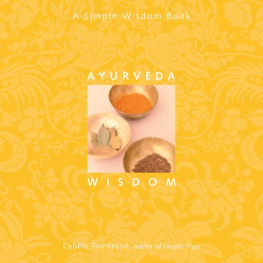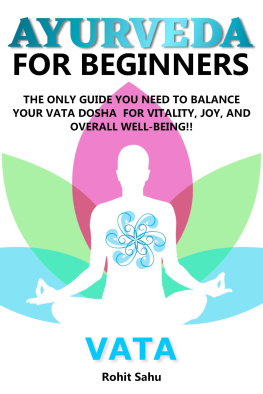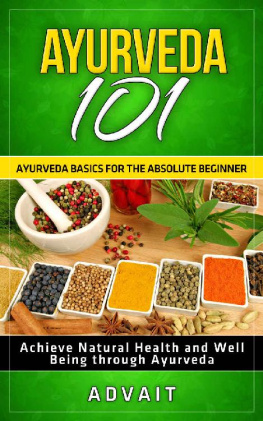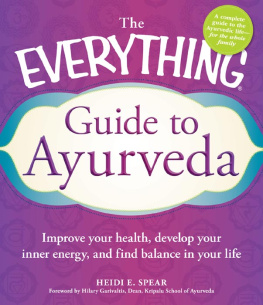

Copyright 2002 Cyble Tomlinson
All Rights Reserved. No part of this book may be used or reproduced in any manner whatsoever without written permission, except in the case of brief quotations in critical articles or reviews. For information, contact:
Conari Press, 2550 Ninth Street, Suite 101,
Berkeley, California 94710-2551.
Conari Press books are distributed by Publishers Group West.
Cover Photograph Nancy Brown/ImageBank
Cover design: Suzanne Albertson
Book design: Claudia Smelser
ISBN: 1-57324-716-2
Library of Congress Cataloging-in-Publication Data
Tomlinson, Cyble.
Ayurveda wisdom / Cyble Tomlinson
p cm.(Simple wisdom book)
Includes bibliographical references and index.
ISBN 1-57324-716-2
1. Medicine, Ayurvedic. I. Title. II. Series.
R605 .T66 2002
615.53dc21 2001005873
Printed in the United States of America on recycled paper.
02 03 04 05 Haddon 10 9 8 7 6 5 4 3 2 1
www.redwheelweiser.com
www.redwheelweiser.com/newsletter
In memory of my father,
Michael Bangs Tomlinson
AYURVEDA WISDOM
PREFACE
I discovered Ayurveda many years ago when I was wandering in a tiny bookstore in Gloucester, Massachusetts, and stumbled on an intriguing Indian cookbook that used Ayurvedic principles. Since it was a cookbook, its focus was, of course, food. But what was different about it, and what was especially appealing to me, was the idea that food could be used for healing the body and bringing the mind into a more balanced state. This was exactly what I was already trying to do through my yoga practice. Later, as I explored a little further, I discovered that yoga and Ayurveda were actually two different branches of the same tradition.
After that early introduction to healthful cooking, it became clear to me that Ayurveda involved a great deal more than food. Ayurveda is a whole philosophy of life that encompasses just about every aspect of day-to-day living, including how we sleep, work, exercise, think, communicate, and many other things. It is meant to help us achieve the highest possible state of health, and its methods are simple, practical, and natural. I have found that the more I explore this vast system of healing, the more I am able to integrate it into my life in ways that are extremely helpful.
For instance, if I feel that I'm getting a cold, I can take certain herbs that will help me ward it off, or I can choose particular foods that will help bolster my immune system. If I find myself becoming overly energized, Ayurveda helps me understand why and provides me with an array of techniques for calming myself so that I feel more balanced. At the present time, I am pregnant, and during my pregnancy, I've been able to make dietary adjustments, take herbs, and practice more selfmassage, one of the self-care techniques recommended in an Ayurvedic lifestyle. Best of all, Ayurveda deepens my understanding of myself and helps me structure regular, healthful routines into my life in such a way that I am likely to stay strong, fit, and balanced most of the time.
Many people associate Ayurveda with the beauty products and spa treatments that have recently become available, and these do, indeed, have their roots in the Ayurvedic tradition. But there is so much more great wisdom in Ayurveda that you can take advantage of, and it's my feeling that even a rudimentary understanding of Ayurveda's principles can help you begin to change your life in simple and commonsense ways that can have lasting benefits for your health.
The purpose of this book is to give you a sense of Ayurveda's scope and provide you with a basic and easy-to-understand foundation. You can use this book to familiarize yourself with some of the concepts of Ayurveda, and you can try out some of the practices that are described. Once you have oriented yourself, you may wish to explore further, and many resources are listed in the back.
one
AYURVEDA, THE SCIENCE OF LONG LIFE
The word Ayurveda can be broken down to its roots: ayur, which means life, and veda, which means knowledge. It is most commonly translated as the science of life or, more specifically, the science of long life.
This ancient Indian system of healing has evolved over many centuries and is believed to be 5,000 years old and possibly older. It is still practiced in India today, and for many Indians, its simpler folk remedies are a normal part of growing up. In the West, in the last fifteen years or so, there has been a wave of new interest in Ayurveda. What Westerners are realizing as they explore Ayurveda is that, while some of the principles and practices may at first seem foreign, the system as a whole makes sense. More important, it works, and people are discovering that Ayurveda has a great deal to offer the modern Western person.
This new interest has partly to do with the sudden and widespread popularity of one of Ayurveda's sister sciences, yoga, which comes out of the same Vedic tradition. Ayurveda and yoga evolved simultaneously and are complementary systems. David Frawley, a scholar of both systems, describes Ayurveda as the healing branch of yogic science, while yoga is the spiritual aspect of Ayurveda. Many people come to Ayurveda through their practice of yoga, but the opposite is true as well. The point is that the two systems are meant to work together.
The idea is to create such abundant health through Ayurveda that we begin to open more and more to the spiritual aspect of our being. The flowering of our health allows and supports us to be more directly in touch with our spiritour innate intelligence, or wisdomand to live more consistently out of that growing awareness. This is the path of yoga, and its final aim is liberation, or Self-realization. Self-realization is said to be an ecstatic state that is quite beyond anything we have previously experienced.
Ayurveda's primary methods for healing are natural: instead of relying on synthetic drugs for quick fixes, Ayurveda mostly uses food, herbs, and gentle lifestyle practices like yoga, breathing exercises, and meditation to cultivate optimal health. Other adjunct therapies that are sometimes used include mantra (chant), massage therapy, self-massage, aromatherapy, gem therapy, and metal and mineral therapies. Through the use of these natural, noninvasive methods, the total health of your being is built up slowly and steadily.
Ayurveda is nature-based in another sense as well. Each person is seen as part of an even greater whole: we exist not in some void by ourselves, but within the natural world. This world has certain irrefutable laws and patterns that regulate all that exists: we see this every day in the simple rising and setting of the sun. As creatures that are part of this natural order, we also are subject to the laws of naturethe laws of our own human nature. It makes sense that if we live according to these laws, we have a much better chance of surviving and enjoying a healthy life. If, on the other hand, we don't align ourselves with these laws, then disease, disharmony, and unhappiness result.
For example, suppose you are the kind of person who happens to need a fair amount of sleep, but you keep staying up late. Then, because you have to get up early in the morning to go to work, you end up drinking lots of coffee during the day to stay awake. The coffee actually gives you indigestion, and over time you start having stomach problems. Because your stomach is bothering you, you can't manage to get to bed at a reasonable hour. In this way, an unhealthy cycle gets set up, which could have been avoided entirely if there had been some recognition of your natural need for more sleep. This is a simple example, but it illustrates how Ayurveda's purpose is to realign us with our own nature.
Next page












